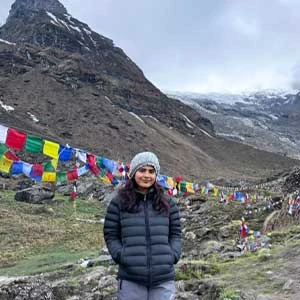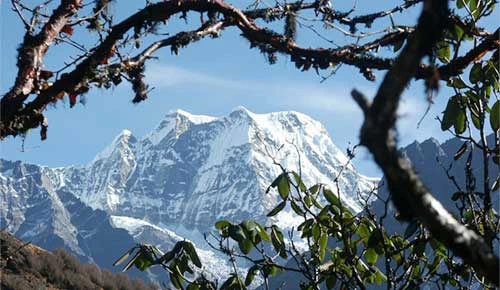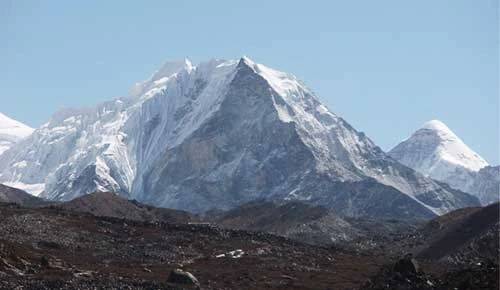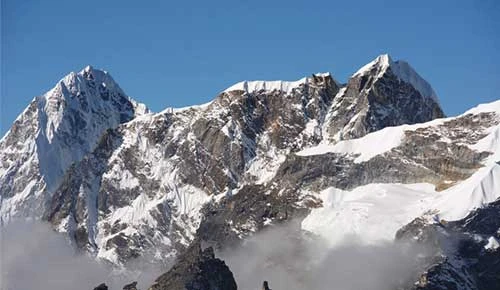Lobuche Peak Climbing: A Thrilling Alternative to the Everest Base Camp Trek
In the shadow of the world’s highest peak, a quieter summit waits to be explored: Lobuche Peak, standing tall at 6,119 meters in Nepal’s Khumbu region. While thousands of trekkers follow the famous Everest trek, only a few take the path that climbs higher toward Lobuche Peak. It’s a journey that goes beyond trekking, leading you closer to the heart of the Himalayas.
Lobuche Peak Climbing gives you the full Everest experience with an extra layer of adventure. You still witness the majestic peaks of Everest, Lhotse, Nuptse, and Ama Dablam, but now you do it from a true Himalayan summit. The climb combines trekking beauty with alpine challenge, where each step takes you closer to the feeling of real accomplishment. It’s perfect for trekkers who have dreamed of going beyond the trails and who want to touch snow, use ropes, and see the sunrise from above 6,000 meters.
If the Everest Base Camp trek is the dream every adventurer knows, Lobuche Peak Climbing is the next step, a perfect blend of trekking and mountaineering, with stunning landscapes, fewer crowds, and a feeling of true accomplishment at the top.
Where are Lobuche Peak and Everest Base Camp?
Lobuche Peak and Everest Base Camp both lie in the Khumbu region of northeastern Nepal, inside the Sagarmatha National Park, a UNESCO World Heritage Site. The area is part of the majestic Himalayas and is home to Sherpa villages, ancient monasteries, and breathtaking mountain scenery.
Lobuche Peak (6,119 m) stands close to the Khumbu Glacier, just a few kilometers southwest of Everest Base Camp. It actually has two main summits, Lobuche East and Lobuche West, with Lobuche East being the one commonly climbed by trekkers and mountaineers.
Everest Base Camp (5,364 m) sits at the foot of the world’s highest mountain, Mount Everest (8,848.86 m), and serves as the main starting point for expeditions aiming for the summit. Trekkers on the way to Lobuche Peak often follow the same route as the classic Everest Base Camp trek, reaching the base camp before ascending higher toward Lobuche.
Together, these two iconic spots form a key part of the Everest region’s adventure circuit, combining the thrill of high-altitude trekking with the challenge of peak climbing amid the world’s tallest mountains.
Table of Contents
Why Choose Lobuche Peak Over EBC Trek?
Same Route, Greater Reward
The trail to Lobuche Peak Climbing follows the classic route through the Khumbu region, passing iconic Sherpa villages such as Namche Bazaar, Tengboche, and Dingboche, where rich culture and breathtaking mountain views unfold at every step. You’ll walk across suspension bridges, visit ancient monasteries, and enjoy the same breathtaking views of the Everest range. But instead of stopping at Base Camp, your journey continues to a real Himalayan summit. This makes it more fulfilling; you experience everything the EBC trek offers and then go beyond, climbing toward the sky where the mountains truly begin.
Real Himalayan Summit Experience
While many treks in the Khumbu region bring you close to Everest, Lobuche Peak Climbing takes you even higher, letting you stand proudly on your own 6,119-meter Himalayan summit. The feeling of reaching the top is unlike anything else: the wind is colder, the silence is deeper, and the sense of pride is much stronger. You use climbing gear like ropes, harnesses, and crampons, but the climb is achievable for fit trekkers with some preparation. It’s a safe, guided adventure that transforms you from a trekker into a true Himalayan climber.
Spectacular Views from the Summit
Few moments in the Himalayas compare to standing on Lobuche Peak and seeing the panorama of Everest, Lhotse, Nuptse, Ama Dablam, Makalu, and Pumori all around you. The view is even more rewarding than what you see from Kala Patthar or any other part because you’re looking at the entire Everest range from above. It’s the kind of view that makes every step worth it, where the sky feels closer and the world below fades into clouds and light.
Perfect Mix of Trekking and Climbing
Lobuche Peak Climbing offers the ideal balance between trekking comfort and mountaineering adventure. You trek through scenic trails, acclimatize in cozy teahouses, and then prepare for a few days of real climbing at high altitude. It’s not as extreme as technical expeditions like Ama Dablam or Island Peak, but it still gives a powerful taste of Himalayan climbing. For many, it becomes the bridge between classic treks and bigger mountaineering dreams.
Fewer Crowds, More Serenity
While many popular trails in the Himalayas can feel crowded during peak seasons, Lobuche Peak Climbing offers a quieter and more peaceful experience. Lobuche Peak, on the other hand, sees far fewer climbers. This means quieter campsites, peaceful trails, and more personal space to connect with nature. You can enjoy the Everest region without the rush of large trekking groups, making your adventure more authentic and meditative.
Ideal for Experienced Trekkers Seeking a Challenge
For those who have already tried high-altitude trekking, Lobuche Peak is the ideal next step. It bridges the gap between trekking and real mountaineering. It’s a logical progression for trekkers who want to push themselves further and gain mountaineering experience. The climb helps build confidence with altitude, ice, and rope work, all while staying within reach of guided safety. It’s an achievable challenge that feels both daring and deeply satisfying.
More Value for Your Adventure
When you compare the cost of Lobuche Peak Climbing with regular treks in the Everest region, the price difference is small but the experience feels far greater. You get the same trekking route, accommodation, and meals, plus climbing permits, gear, and training for a real Himalayan summit. The value you gain from standing on top of a mountain, with Everest right before your eyes, is priceless. It’s an adventure that goes beyond the ordinary and stays with you long after the climb is done.
The Trekking Route to Lobuche Peak
The journey to Lobuche Peak follows one of the most scenic and rewarding trails in the Everest region. It begins with a short flight to Lukla and gradually ascends through lush forests, Sherpa settlements, and high-altitude valleys before reaching the iconic Everest Base Camp. From there, climbers continue toward Lobuche Base Camp and the summit. Below is a detailed breakdown of the key route sections, elevations, and highlights along the way:
Route Section | Elevation (approx.) | Highlights |
Kathmandu – Lukla – Phakding | 2,610 m | Scenic mountain flight to Lukla, first glimpse of the Everest region, riverside trails. |
Phakding – Namche Bazaar | 3,440 m | Crossing suspension bridges, entrance to Sagarmatha National Park, Sherpa culture in Namche. |
Namche–Tengboche | 3,860 m | Rhododendron forests, Tengboche Monastery, and close-up views of Ama Dablam and Everest. |
4,410 m | Open valleys, alpine vegetation, and a gradual climb with panoramic Himalayan views. | |
Dingboche – Lobuche | 4,910 m | Walk through memorial chortens and take in breathtaking views of Pumori and Nuptse. |
Lobuche – Everest Base Camp – Gorak Shep | 5,364 m | Visit iconic Everest Base Camp, enjoy glacier landscapes, and stay at the highest teahouse point. |
Gorak Shep – Kala Patthar – Lobuche Base Camp | 5,545 m | Sunrise viewpoint over everest |
Lobuche Base Camp – High Camp – Summit | 6,119 m | Ice and snow climb with ropes and crampons, panoramic summit views of Everest, Lhotse, and Ama Dablam. |
Summit – Pangboche – Namche – Lukla | 2,860 m | Descend through Sherpa villages, celebrate summit success, and return to Lukla for the flight back. |
Each part of the Lobuche Peak Climbing route offers something special. You start by walking through green valleys and Sherpa villages, then move higher toward snow-covered mountains. The trail gives you both culture and adventure: the beauty of the Everest Base Camp trek and the thrill of reaching a real Himalayan summit. Standing on top of Lobuche Peak (6,119 m) is an unforgettable moment that makes every step of the journey worth it.
Acclimatization and Safety Tips
Proper acclimatization is the key to a successful climb to Lobuche Peak (6,119 m). As you gain altitude, the oxygen level in the air drops, and your body needs time to adjust. Without enough acclimatization, even fit trekkers can suffer from altitude sickness. The route to Lobuche Peak is well-designed to help your body adapt gradually, especially with rest days built in along the Everest Base Camp trail. If these things are not monitored properly, people may get altitude illness HAPE or HACE.
Here are some of the common symptoms of HAPE (High Altitude Pulmonary Edema) — a serious and potentially life-threatening altitude illness caused by fluid accumulation in the lungs:
- Shortness of breath even at rest
- Persistent cough (sometimes with frothy sputum)
- Chest tightness or pain
- Fatigue and weakness
- Bluish lips or fingernails
Here are the symptoms of HACE (High Altitude Cerebral Edema) — a serious and potentially life-threatening altitude illness caused by brain swelling due to low oxygen levels at high altitudes:
- Severe headache and confusion
- Loss of coordination or balance
- Dizziness and vomiting
- Hallucinations or strange behavior
- Loss of consciousness (in serious cases)
Safety Tips for Lobuche Peak Climb
- Ascend slowly and allow proper time for acclimatization.
- Take rest days at Namche Bazaar and Dingboche.
- Drink plenty of water and warm fluids to stay hydrated.
- Eat high-energy meals with carbohydrates and soups.
- Follow the “climb high, sleep low” principle.
- Avoid alcohol, smoking, and caffeine at high altitude.
- Watch for any symptoms of altitude sickness and act early.
- Always listen to your guide and follow safety instructions.
- Use proper climbing gear: helmet, harness, crampons, and ice axe.
- Take regular breaks and avoid overexertion.
Climbing Experience of Lobuche Peak
Climbing Lobuche Peak (6,119 m) is both challenging and rewarding. It combines the beauty of the Everest Base Camp trail with the thrill of standing on a Himalayan summit. The climb is ideal for trekkers looking to take their first step into mountaineering, offering a mix of scenic trekking, technical sections, and breathtaking views from the top.
Here’s what the climb experience is like:
Starting the Climb from Lobuche Village
The climb begins after reaching Lobuche village, where trekkers branch off from the main Everest Base Camp trail. The path to Base Camp follows rocky terrain along the Khumbu Glacier. This section is relatively gentle, giving climbers time to adjust before tackling the higher and more technical parts of the mountain.
The gradual ascent allows climbers to adjust to the altitude while experiencing the local Sherpa culture in the small settlements along the trail. It’s also a chance to enjoy the serenity of the mountains before the technical climb begins.
Setting Up at Base Camp (4,950 m)
Base Camp sits on a rugged, open area surrounded by snow peaks. Climbers spend the day organizing gear, resting, and attending a short briefing. Guides usually conduct a training session here, teaching basic techniques like using crampons, ropes, and ice axes perfect for beginners entering the world of mountaineering.
For beginners, this is an invaluable introduction to climbing at high altitude. The evening is spent enjoying a warm meal, reviewing the route, and resting early to ensure the body is ready for the next day’s climb to High Camp.
Ascent to High Camp (around 5,400 m)
From Base Camp, the route climbs steeply over rocky moraines and loose scree to High Camp. The air grows thinner, and every step demands focus and pacing. Upon reaching High Camp, climbers enjoy light meals, hydrate well, and rest early for the midnight summit push.
The evening is spent double-checking gear, melting snow for drinking water, and enjoying warm meals before settling in early. The excitement and nervous anticipation for the summit push make it hard to sleep, but rest is crucial for the long climb ahead.
The Early Morning Summit Push
The final ascent starts before dawn, usually between 2:00 and 3:00 a.m. Using headlamps, climbers move in rope teams over icy slopes and snow ridges. The air is crisp and cold, but the stars overhead and the sound of crampons on ice create an unforgettable Himalayan atmosphere.
The route includes gradual slopes followed by a few steeper sections fixed with ropes for safety. By the time the sun rises, the peaks of Everest, Lhotse, and Ama Dablam appear in golden light, a view so stunning it makes every moment of the climb worthwhile.
Technical Climbing Sections
Higher up, the slope becomes steeper, requiring the use of fixed ropes and safety harnesses. With guidance from the climbing leader, climbers use ascenders (jumars) to move steadily upward. Though physically demanding, the route is considered achievable for those with moderate fitness and basic climbing knowledge.
The climb involves a combination of snow, ice, and rocky ridges, requiring concentration and careful footwork. While physically demanding, these sections are designed for climbers with moderate fitness and basic mountaineering skills. The support of guides and the use of proper equipment make the experience thrilling but manageable.
Reaching the Summit (6,119 m)
The final push to the summit is unforgettable. As dawn breaks, the first golden rays illuminate the peaks of Everest, Lhotse, Nuptse, Pumori, and Ama Dablam, creating a panoramic view that stretches across the Khumbu region.
Standing on top of Lobuche Peak, climbers feel a mix of exhilaration, pride, and awe a reward for all the effort, preparation, and determination that went into the climb. The summit offers the perfect opportunity for photos, reflection, and savoring the sheer beauty of the Himalayas from one of its high vantage points.
Descent and Return
Descending requires equal care, as icy slopes and rocky paths demand steady footing. Climbers retrace their steps back to High Camp and then to Base Camp, often feeling a mix of relief and accomplishment. The descent is physically easier than the ascent but still requires focus, especially when tired.
Once back at Base Camp, climbers can relax, share stories with their team, and celebrate the successful summit. The sense of achievement, combined with memories of the stunning landscapes and camaraderie, makes the entire climb a truly life-changing experience.
Unique Experiences Only Lobuche Peak Offers
Lobuche Peak offers an experience unlike any other in the Himalayas. It combines the scenic trekking of the Everest Base Camp route with the thrill of technical mountaineering, giving climbers both adventure and achievement in a single expedition. Along the way, trekkers pass through Sherpa villages, monasteries, and moraine fields, experiencing the rich local culture and the rugged beauty of the Khumbu region. The summit rewards climbers with stunning 360-degree panoramic views of Everest, Lhotse, Nuptse, Ama Dablam, and Pumori, often framed by the magical glow of sunrise. Here are the key points that make it more unique than the others:
- Offers a real high-altitude summit experience above 6,000 meters.
- Accessible for climbers with moderate fitness and basic mountaineering skills.
- Close encounter with glaciers and icefalls unique to the Khumbu region.
- Opportunity to practice technical climbing skills in a safe, guided environment.
- Stunning moraine landscapes and rugged terrain not seen on typical treks.
- Views of multiple high Himalayan peaks from less crowded vantage points.
- Combines multi-day trekking with summit acclimatization for safer climbing.
- Chance to witness Himalayan wildlife in their natural high-altitude habitat.
Beyond the Trails, Toward the Summit
Lobuche Peak Climbing is a complete Himalayan experience with scenic trails, peaceful Sherpa villages, and a real taste of mountaineering. You experience all the beauty and adventure of the Everest region, then go a step further, rising above the trails to witness the world from a real Himalayan summit. It’s a balanced adventure not too technical, not too easy, just the right mix of challenge, beauty, and calm. For anyone dreaming of a climb that feels real but is still achievable, Lobuche Peak is a perfect choice.
Book your Lobuche Peak Climbing adventure with Nepal Trek Adventures (NTA) and experience the Everest region like never before.








